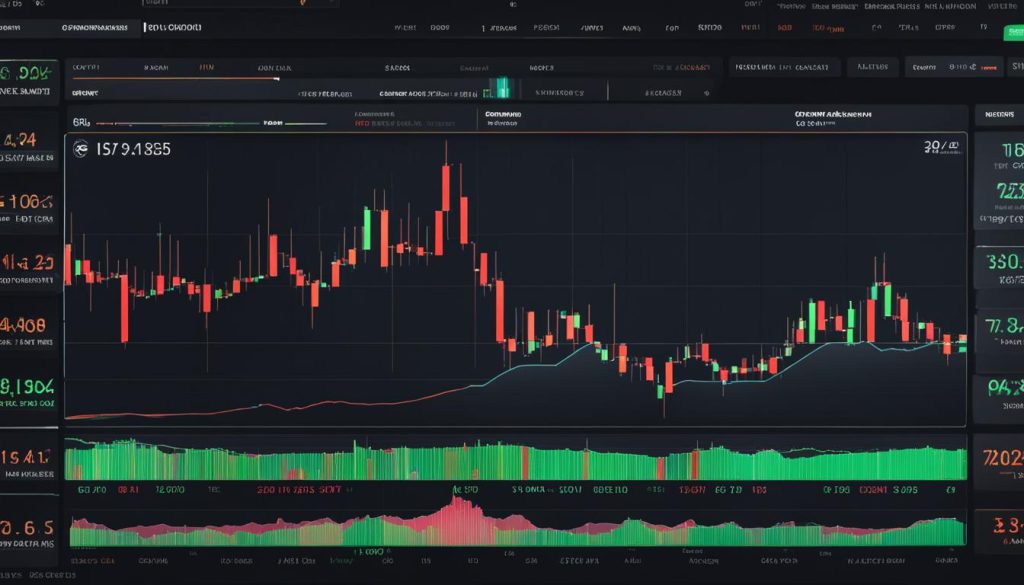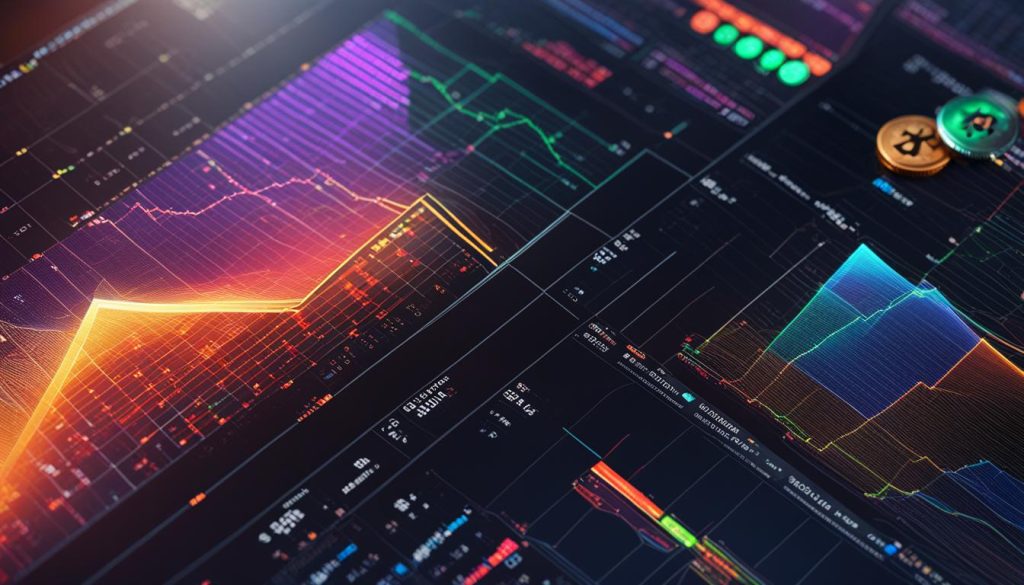Are you interested in cryptocurrencies and eager to enhance your trading skills? Understanding cryptocurrency technical analysis can be a game-changer in the fast-paced world of crypto trading. By analyzing market trends, charts, and indicators, you can make more informed trading decisions and increase your chances of success.
Technical analysis is a method of evaluating securities in the cryptocurrency market using statistical data derived from market activity. It involves studying the historical prices, volume, and chart patterns to identify trends and predict future price movements. While technical analysis isn’t foolproof, it can provide valuable insights for traders to navigate the volatile cryptocurrency market.
Key Takeaways:
- Cryptocurrency technical analysis uses past market data to identify trends and make trade decisions.
- Chart patterns, moving averages, and indicators are vital tools for technical analysis.
- Support and resistance levels act as barriers to price movements and help determine entry and exit points.
- Technical analysis can be applied to both cryptocurrency trading and investment strategies.
- Continuous learning and staying up-to-date with new developments are crucial for mastering technical analysis.
Understanding Chart Patterns in Cryptocurrency Technical Analysis
Chart patterns play a crucial role in cryptocurrency technical analysis. By identifying these patterns, traders can gain insights into market trends and make informed trade decisions. Some common chart patterns include head and shoulders, triangles, and double tops and bottoms. These patterns offer valuable information about potential price movements and can help traders determine support and resistance levels.
When analyzing chart patterns, it’s important to pay attention to the shape, duration, and volume associated with the pattern. For example, a head and shoulders pattern consists of three peaks, with the middle peak being the highest. This pattern suggests a potential trend reversal, with a downward movement anticipated.
| Chart Pattern | Description | Implication |
|---|---|---|
| Head and Shoulders | Three peaks, with the middle peak being the highest | Trend reversal and potential downward movement |
| Triangles | Converging lines forming a triangle shape | Consolidation period followed by breakout |
| Double Tops and Bottoms | Two consecutive peaks (tops) or troughs (bottoms) | Reversal of an existing trend |
By understanding chart patterns and their implications, traders can develop effective cryptocurrency trading strategies based on technical analysis. These strategies can help identify potential entry and exit points, as well as predict market trends. It’s important to combine chart pattern analysis with other technical indicators to validate signals and enhance overall trading accuracy.
Utilizing Moving Averages in Cryptocurrency Technical Analysis
Moving averages are a crucial tool in cryptocurrency technical analysis. They are trend-following indicators that show the average price of a security over a specific period of time. By utilizing moving averages, traders can gain insights into the overall market trends and make informed trade decisions.
There are various types of moving averages, but the most commonly used ones in technical analysis are the 50-day moving average and the 200-day moving average. The 50-day moving average provides a shorter-term perspective on price movements, while the 200-day moving average offers a longer-term view. Traders often look for crossovers between these moving averages to identify potential trend changes.
In addition to identifying trends, moving averages can also be used to analyze price action and predict market volatility. When the price consistently stays above the moving average, it indicates a bullish trend, while a price consistently below the moving average suggests a bearish trend. By analyzing the relationship between the price and the moving averages, traders can assess market volatility and adjust their strategies accordingly.
Overall, moving averages are a valuable tool for cryptocurrency traders as they provide a clear visual representation of market trends and help traders make informed decisions. By incorporating moving averages into their technical analysis, traders can enhance their understanding of market dynamics and improve their trading strategies.
Table: Moving Averages
| Type | Description |
|---|---|
| Simple Moving Average (SMA) | Calculates the average price over a specified time period. |
| Exponential Moving Average (EMA) | Gives more weight to recent prices, making it more responsive to current market conditions. |
| Weighted Moving Average (WMA) | Gives different weights to prices based on their importance, placing more emphasis on recent data. |
Each type of moving average has its own advantages and disadvantages, and traders may choose to use different types based on their trading strategies and preferences.

“Moving averages are an essential tool for gauging market trends and volatility in cryptocurrency technical analysis. By studying the relationship between the price and different moving averages, traders can make informed trade decisions and adapt their strategies accordingly.” – Crypto Trader
Exploring Indicators in Cryptocurrency Technical Analysis
Cryptocurrency technical analysis relies on a range of indicators to assist traders in identifying trends and making informed trade decisions. These indicators provide valuable insights into price momentum, trend direction, and market volume. By understanding and utilizing indicators effectively, traders can enhance their technical analysis and improve their overall trading strategies.
One commonly used indicator in cryptocurrency technical analysis is the Relative Strength Index (RSI). The RSI measures the speed and change of price movements and helps traders determine whether a cryptocurrency is overbought or oversold. This can indicate potential reversal points and assist in timing entry or exit positions.
Another widely used indicator is the Moving Average Convergence Divergence (MACD), which identifies potential trend changes by comparing short-term and long-term moving averages. The MACD provides traders with signals based on the crossover of these moving averages, indicating potential buy or sell opportunities.
Furthermore, the On-Balance Volume (OBV) indicator is employed to assess buying and selling pressure in the market. It measures the cumulative sum of volume based on price movements, helping traders determine the strength of a trend and identify potential reversals.
| Indicator | Description |
|---|---|
| Relative Strength Index (RSI) | Measures price momentum and overbought/oversold levels. |
| Moving Average Convergence Divergence (MACD) | Compares short-term and long-term moving averages to identify trend changes. |
| On-Balance Volume (OBV) | Assesses buying and selling pressure in the market based on volume. |
“The use of indicators adds a layer of analysis to technical analysis, providing traders with valuable insights into market dynamics and potential trade opportunities.” – Crypto Trader
By incorporating these indicators into their technical analysis, traders can gain a more comprehensive understanding of market trends and make more confident trade decisions. However, it’s important to note that indicators should not be used in isolation, but rather in conjunction with other analysis methods to increase the accuracy of predictions and minimize risks.
Incorporating Support and Resistance Levels in Cryptocurrency Technical Analysis
Support and resistance levels play a crucial role in cryptocurrency technical analysis, helping traders identify optimal entry and exit points in the market and determine the timing of their trades. Support levels act as price points where demand is strong enough to prevent further price declines, while resistance levels act as barriers where supply is strong enough to prevent further price increases.
By analyzing support and resistance levels on cryptocurrency charts, traders can gain valuable insights into market sentiment and expectations. When the price approaches a support level, it indicates that buyers are likely to enter the market, creating upward pressure on the price. Conversely, when the price approaches a resistance level, it suggests that sellers may sell off their positions, creating downward pressure on the price.
Traders can use these support and resistance levels to set stop-loss orders, which help manage risk by automatically closing positions when the price breaks below support or above resistance. This allows traders to protect their capital and limit potential losses. Additionally, support and resistance levels can be used as targets for taking profits, indicating price levels where traders may consider closing their positions to secure gains.
| Support and Resistance Levels | Description |
|---|---|
| Support Levels | Price points where demand is strong enough to prevent further price declines. |
| Resistance Levels | Price points where supply is strong enough to prevent further price increases. |
The proper identification of support and resistance levels requires careful analysis of historical price data and an understanding of market psychology. Traders can use various tools and techniques, such as trend lines, horizontal levels, and pivot points, to identify these key levels on charts. It’s important to note that support and resistance levels are not fixed, and they can change over time as market conditions evolve.
When incorporating support and resistance levels into their technical analysis, traders should consider other factors as well, such as volume, market trends, and indicators. By combining multiple analysis techniques, traders can strengthen their decision-making process and improve their chances of success in the cryptocurrency market.
Overall, understanding and incorporating support and resistance levels in cryptocurrency technical analysis can provide valuable insights into market dynamics and help traders make more informed and strategic trading decisions. By using these levels effectively, traders can enhance their ability to identify profitable opportunities and manage risk, leading to improved performance in the crypto market.

Implementing Technical Analysis in Cryptocurrency Trading
When it comes to cryptocurrency trading, implementing technical analysis can be a game-changer. By utilizing various technical analysis tools and techniques, you can make more informed trading decisions and potentially improve your overall performance. Here are some key strategies to consider:
1. Utilize Crypto Trading Bots
Crypto trading bots are automated software programs that can execute trades on your behalf. These bots are designed to analyze market data, identify trends, and execute trades based on predefined parameters. By using crypto trading bots, you can take advantage of market opportunities even when you’re not actively monitoring the market.
2. Explore Copy Trading
Copy trading allows you to replicate the trades of experienced and successful traders. By following their trading strategies and insights, you can leverage their expertise and potentially achieve similar results. Many crypto exchanges offer copy trading features, making it easier for you to follow and learn from top traders.
3. Choose the Best Crypto Exchanges
The choice of exchange plays a crucial role in your trading success. Look for reputable exchanges that offer a wide range of cryptocurrencies, competitive fees, and advanced trading features. Additionally, consider factors such as security measures, user-friendly interface, and liquidity. Some popular crypto exchanges include Binance, Coinbase, and Kraken.

By incorporating technical analysis into your trading approach and utilizing tools like crypto trading bots and copy trading, you can enhance your decision-making process and potentially increase your chances of success in the cryptocurrency market.
Remember, cryptocurrency trading involves risks, and no strategy guarantees profits. It’s essential to continuously educate yourself, stay updated with market trends, and practice risk management to protect your capital.
Steps for Using Technical Analysis in Cryptocurrency Trading
When it comes to cryptocurrency trading, technical analysis plays a crucial role in helping you make informed decisions. By following a systematic approach and utilizing various tools and methods, you can enhance your trading strategies and potentially improve your overall profitability. Here are the steps you can follow to effectively use technical analysis in your cryptocurrency trading:
- Select a cryptocurrency: Begin by conducting thorough research and due diligence to choose a cryptocurrency that aligns with your trading goals and risk appetite.
- Choose a time frame: Determine the time frame for your analysis, such as hourly, daily, weekly, or monthly charts. This will help you identify trends and patterns more effectively.
- Identify chart patterns: Learn to recognize chart patterns such as head and shoulders, triangles, or double tops and bottoms. These patterns can indicate potential trend reversals or continuation.
- Determine support and resistance levels: Identify key support and resistance levels on the chart, which act as significant barriers to price movements. These levels can help you establish optimal entry and exit points for your trades.
- Use moving averages and indicators: Employ various moving averages and indicators to confirm trend changes and generate trade signals. Examples include the 50-day and 200-day moving averages, as well as popular indicators like the relative strength index (RSI) and moving average convergence divergence (MACD).
- Implement risk management: Set stop-loss orders to manage your risk and protect your capital. This ensures that you have predefined exit points in case the market moves against your trade.
By following these steps, you can integrate technical analysis effectively into your cryptocurrency trading strategy. Remember that technical analysis is not foolproof, and it’s important to combine it with other analysis methods and risk management practices. Continually learning and adapting your approach based on market conditions will help you refine your trading strategy and potentially increase your chances of success.

Disclaimer: This image is for illustrative purposes only and does not represent actual trading strategies.
The Role of Technical Analysis in Cryptocurrency Investment
When it comes to cryptocurrency investment, understanding market trends and making informed decisions is crucial. This is where technical analysis plays a key role. By analyzing charts, patterns, and indicators, you can identify opportune times to enter or exit a cryptocurrency investment.
Unlike fundamental analysis, which evaluates the underlying value and metrics of a cryptocurrency project, technical analysis focuses on price movements and historical data. It uses tools such as support and resistance levels, moving averages, and indicators like the Relative Strength Index (RSI) and Moving Average Convergence Divergence (MACD) to predict market trends and make investment decisions based on market behavior.
While technical analysis is not a foolproof method and should be used in conjunction with other analysis approaches, it can provide valuable insights to cryptocurrency investors. By combining technical analysis with fundamental analysis, investors can gain a more comprehensive understanding of the market and potentially maximize their returns.
Technical Analysis vs Fundamental Analysis
Both technical analysis and fundamental analysis have their merits and limitations. Technical analysis focuses on past price data and patterns to predict future price movements, while fundamental analysis assesses the intrinsic value of an asset based on economic factors, project fundamentals, and market conditions.
Technical analysis is particularly useful in volatile markets like cryptocurrency, where price movements can be swift and unpredictable. It allows investors to take advantage of short-term price fluctuations and identify trends that may not be evident through fundamental analysis alone.
On the other hand, fundamental analysis provides a more holistic view of a cryptocurrency project’s long-term prospects. It helps investors understand the technology, team, partnerships, and market demand behind a cryptocurrency, which can be essential for long-term investment strategies.
Ultimately, the best approach is to combine both technical and fundamental analysis to make informed investment decisions. By utilizing these complementary methods, you can gain a deeper understanding of the cryptocurrency market and increase your chances of success.

Recommended Resources for Learning Cryptocurrency Technical Analysis
If you’re looking to enhance your knowledge of cryptocurrency technical analysis, there are various resources available to help you gain insights and refine your trading strategies. Here are some recommended resources:
1. Books:
- “Rich Dad Poor Dad” by Robert Kiyosaki: While not directly focused on cryptocurrency, this personal finance book provides valuable insights into money and wealth-building, which can be applied to your trading approach.
- “The Psychology of Money”: This book delves into the psychological factors that influence attitudes towards money, offering valuable perspectives for understanding the mindset and emotions involved in cryptocurrency trading.
- “Blockchain Bubble or Revolution: The Future of Bitcoin, Blockchains, and Cryptocurrencies”: This book explores the potential impact of blockchain technology and provides valuable insights into the future of cryptocurrencies.
- “Proof of Stake: The Making of Ethereum and the Philosophy of Blockchains”: For those interested in Ethereum and the concept of proof of stake, this book offers an in-depth examination of its development and the broader philosophy of blockchains.
2. Online Communities:
Joining online communities can provide valuable insights and educational content on crypto trading and investing. Consider the following:
- Coinmonks Telegram Channel: A community of cryptocurrency enthusiasts and traders sharing insights, analysis, and educational resources.
- Coinmonks Youtube Channel: A platform featuring video content on a wide range of cryptocurrency topics, including technical analysis strategies and tutorials.
By utilizing these resources, you can enhance your understanding of cryptocurrency technical analysis and deepen your insights into the complex world of crypto trading.

Conclusion
Technical analysis is a vital tool for navigating the cryptocurrency market. By analyzing chart patterns, support and resistance levels, moving averages, and indicators, you can gain valuable insights into market trends and make informed trading decisions. While technical analysis should be used in conjunction with other analysis methods, it is an essential component of successful cryptocurrency trading and investment.
Remember that technical analysis is not foolproof, and the market can be unpredictable. Continually learning and staying informed about new developments and strategies will enhance your expertise in cryptocurrency technical analysis.
As you delve deeper into the world of cryptocurrency, consider expanding your knowledge by exploring recommended resources and joining online communities. By applying what you’ve learned and staying proactive, you can develop effective strategies and maximize your success in the crypto market. Good luck!
FAQ
What is technical analysis in cryptocurrency trading?
Technical analysis is a method of evaluating securities in the cryptocurrency market using statistics generated by market activity, such as past prices and volume. It involves analyzing chart patterns, support and resistance levels, moving averages, and indicators to identify trends and make trade decisions.
How can chart patterns be used in technical analysis?
Chart patterns are used to identify trends and make trade decisions in technical analysis. Common chart patterns include head and shoulders, triangles, and double tops and bottoms. Traders can use chart patterns to determine support and resistance levels, which act as barriers to price movements.
What are moving averages and how are they used in technical analysis?
Moving averages are trend-following indicators that show the average price of a security over a set period of time. Traders use moving averages to analyze price action, identify trend changes, and predict market volatility.
What indicators are commonly used in technical analysis?
Common indicators used in technical analysis include the relative strength index (RSI), the moving average convergence divergence (MACD), and the on-balance volume (OBV). These indicators measure price momentum, trend direction, and volume in the market.
How do support and resistance levels impact technical analysis?
Support and resistance levels are price points on a chart that act as barriers, preventing the price from moving beyond them. Traders can use support and resistance levels to identify entry and exit points in the market and determine optimal timing for their trades.
How can technical analysis be incorporated into cryptocurrency trading strategies?
Traders can incorporate technical analysis into their cryptocurrency trading strategies by following steps such as selecting a cryptocurrency to trade, choosing a time frame for analysis, identifying chart patterns, determining support and resistance levels, using moving averages and indicators, and setting stop-loss orders.
Can technical analysis be used for cryptocurrency investing?
Yes, technical analysis can be valuable for cryptocurrency investors. By analyzing trends, patterns, and indicators, investors can identify opportune times to enter or exit a cryptocurrency investment. Technical analysis can complement fundamental analysis, which evaluates the underlying value and metrics of a cryptocurrency project.
What resources are recommended for learning cryptocurrency technical analysis?
Recommended resources for learning cryptocurrency technical analysis include books like “Rich Dad Poor Dad” by Robert Kiyosaki, “The Psychology of Money,” “Blockchain Bubble or Revolution: The Future of Bitcoin, Blockchains, and Cryptocurrencies,” and “Proof of Stake: The Making of Ethereum and the Philosophy of Blockchains.” Joining online communities and channels dedicated to crypto trading and investing can also provide valuable insights and educational content.
How can technical analysis enhance cryptocurrency trading and investment?
Technical analysis is a powerful tool that can assist traders and investors in making informed decisions in the cryptocurrency market. By analyzing chart patterns, support and resistance levels, moving averages, and indicators, individuals can identify trends, predict price movements, and develop effective trading strategies. While technical analysis is not foolproof and should be used in conjunction with other analysis methods, it is an essential component of successful cryptocurrency trading and investment.

